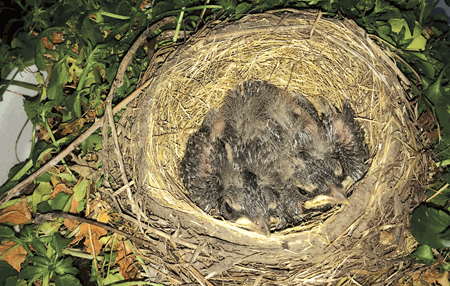SAVE THE BIRDS
 One hundred years ago, in 1916, representatives of the United States and Great Britain signed the Migratory Bird Treaty.
One hundred years ago, in 1916, representatives of the United States and Great Britain signed the Migratory Bird Treaty.
Great Britain signed for Canada. The Migratory Bird Treaty was an agreement to save the birds of North America.
From the time settlers from Europe had begun coming to America, the resources of this new land, including the birds, had been considered inexhaustible.
Why wouldn’t they think this? Consider the passenger pigeon, the supreme example. The passenger pigeon was once probably the most numerous bird in the world. In 1813, James Audubon wrote of a flock that took three days to fly by. “The light of the noonday sun was obscured as by an eclipse,” Audubon wrote. Historians have estimated that there were 3 to 5 billion passenger pigeons.
For comparison, today, the red-winged blackbird is one of the most numerous birds of North America and its numbers are estimated at 150 to 160 million. By the time the Migratory Bird Treaty was signed, however, the passenger pigeon was extinct. It had been driven to extinction by hunting, not just shooting, but killing in every way. Passenger pigeons nested in huge colonies. And trees, in which they nested, were felled and the squabs were killed. Tons of passenger pigeons were shipped to markets in eastern cities.
The passenger pigeon wasn’t the only bird of North America that was driven to extinction. The Labrador duck, the Carolina parakeet and the Eskimo curlew were also extinct by the time the Migratory Bird Treaty was signed. Other species, including the great and the snowy egret, had been reduced to low numbers and would almost certainly have become extinct if they had not been given protection.
The Migratory Bird Treaty banned pursuing, hunting, taking, capturing and killing any migratory bird of North America. It banned possessing, selling, purchasing, bartering, importing or exporting any migratory bird of North America, or part, nest or egg of such bird, without a permit issued by the Secretary of the Interior. It also defined a migratory bird as a bird that may move from place to place.
The Migratory Bird Treaty, however, was not a law. It was an agreement between nations and did not provide bird protection. Two years later, in 1918, the U.S. Congress passed the Migratory Bird Treaty Act and President Woodrow Wilson signed it, making it law. In the Migratory Bird Treaty Act, birds are classified as migratory game birds, migratory non-game and non-native.
Migratory game birds may be hunted, but only during prescribed seasons and the hunting season for any bird may not be longer than 3 1/2 months. Migratory non-game birds, those birds that are not game birds, may move from place to place.
What bird won’t move from one place to another?
Finally, non-native birds, starling and house sparrow, rock pigeon and monk parakeet, are not protected.
The Migratory Bird Treaty Act is not enforced strictly. If it was, I would have been in trouble with the law often, particularly as a boy. I picked up baby birds that were out of the nest, took them home and managed to raise a number of them. I picked up injured birds and tried to care for them, usually without success. As a result of my failures to nurse injured birds back to health, I had a bird cemetery with wooden crosses behind our garage. I picked up bird feathers. I had a collection of bird nests. I never collected a nest when there were eggs or nestlings in it, however.
The birds of North America have been protected by law for nearly 100 years. Their habitat has not, however, and as a result, habitat loss and now global warning, it is estimated that birds of North America have declined by approximately 40 percent.
- Birds As Weather Forecasters – Life In The Outdoors - December 17, 2021
- Rare Bird Spotted In Indiana – Life In The Outdoors - October 8, 2021
- MY EXPERIENCE WITH DEER – Life In The Outdoors - July 30, 2021


